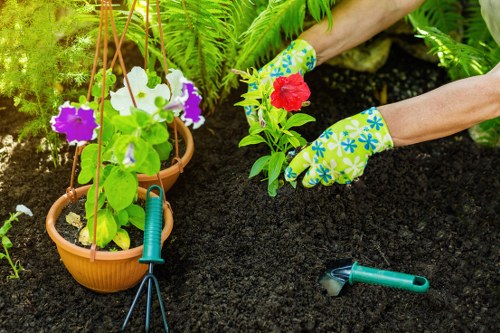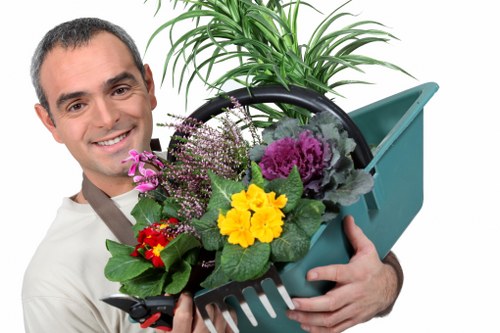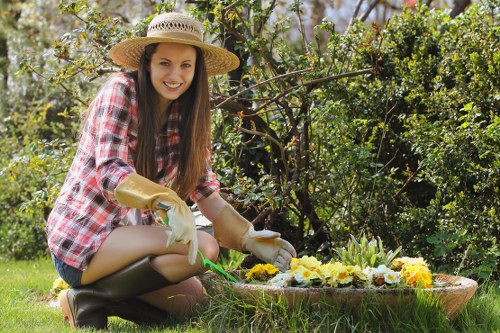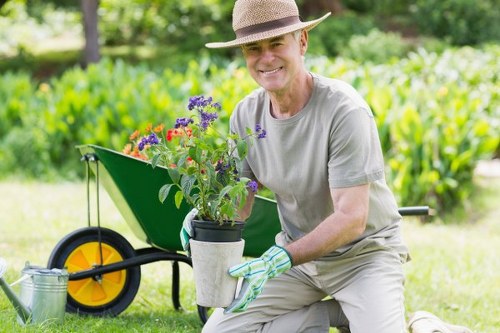Lawn Turf Installation in Garden Fencing
Introduction to Lawn Turf and Garden Fencing

Creating a picturesque and functional outdoor space is a dream for many homeowners. Combining lawn turf installation with garden fencing can significantly enhance both the aesthetic and practical aspects of your garden. A lush green lawn not only provides a serene backdrop but also serves as a versatile area for recreation and relaxation. When paired with well-designed fencing, it defines boundaries, offers privacy, and adds structural interest to your landscape.
Integrating turf and fencing requires thoughtful planning and execution to ensure that both elements complement each other and contribute to the overall harmony of the garden. From selecting the right turf variety to choosing the appropriate fencing material, each decision plays a crucial role in achieving a cohesive and attractive outdoor space.
This comprehensive guide explores the benefits of combining turf installation with garden fencing, the steps involved in preparing and installing both elements, maintenance tips, and common mistakes to avoid. Whether you’re a gardening enthusiast or a homeowner looking to enhance your property, understanding the synergy between turf and fencing will help you create a beautiful and functional garden.
Benefits of Combining Lawn Turf Installation with Garden Fencing
Integrating lawn turf installation with garden fencing offers numerous advantages that extend beyond simple aesthetics. Here are some key benefits:
Enhanced Privacy
Garden fencing provides a barrier that offers privacy from neighbors and passersby. When combined with a well-maintained lawn, it creates a secluded oasis where you can enjoy outdoor activities without disturbances. Privacy fencing such as tall wooden or metal panels can shield your turf area from unwanted eyes, creating a personal retreat.
Defined Boundaries
Fencing clearly delineates the edges of your property or specific garden areas. This clarity helps in organizing planting beds, pathways, and recreational zones, ensuring that each space is well-defined and functional. Defined boundaries also prevent the spread of grass into unwanted areas, making maintenance easier.
Increased Property Value
A manicured lawn paired with elegant fencing can significantly boost your property’s curb appeal and market value. Potential buyers are often attracted to well-maintained gardens that showcase both lush turf and quality fencing, seeing them as indicators of a well-cared-for home.
Preparing the Site for Lawn Turf and Fencing Installation

Proper site preparation is fundamental to the successful installation of both lawn turf and garden fencing. It ensures durability, aesthetic appeal, and ease of maintenance. Here’s how to prepare your garden for these installations:
Soil Assessment and Amendment
Begin by assessing the soil quality where the lawn will be installed. Conduct a soil test to determine pH levels and nutrient content. Most turf grasses thrive in slightly acidic to neutral soil (pH 6-7). Amend the soil with lime to raise pH or sulfur to lower it as needed. Incorporate organic matter like compost to enhance soil fertility and structure, promoting healthy grass growth.
Clearing and Leveling the Ground
Remove all existing vegetation, rocks, and debris from the installation area. A clean and level surface is crucial for both turf laying and fence installation. Use a garden rake to break up compacted soil and ensure proper drainage. Leveling the ground prevents water pooling, which can damage both the turf and fencing over time.
Marking Fence Locations
Determine where your garden fence will be placed. Use stakes and string to mark the exact fence line, ensuring it aligns with your garden design. Accurate marking is essential for straight fence installation and avoids future adjustments that could disrupt the laying of turf.
Selecting the Right Turf for Your Garden
Choosing the appropriate turf type is critical for achieving a healthy and attractive lawn. Different grass species have varying requirements and benefits. Consider the following factors when selecting turf:
Climate Suitability
Bold turf varieties are tailored to specific climates. For cooler regions, perennial ryegrass and fescue are excellent choices due to their resilience in temperate conditions. In contrast, warm-season grasses like Bermuda and Zoysia thrive in hotter climates, offering drought resistance and heat tolerance.
Shade Tolerance
Assess the amount of sunlight your garden receives. Some turf types, such as fescue, are more shade-tolerant, making them suitable for gardens with partial or full shade. Other varieties may require full sun exposure to thrive.
Maintenance Requirements
Consider how much time you can dedicate to lawn maintenance. Some turf types require more frequent mowing, watering, and fertilizing. If you prefer a low-maintenance lawn, opt for grass species known for their durability and minimal upkeep needs.
Choosing the Best Garden Fencing Material

The fencing material you choose not only impacts the visual appeal of your garden but also affects maintenance, durability, and cost. Here are some popular fencing materials to consider:
Wood Fencing
Wooden fences offer a classic and natural look that blends seamlessly with a green lawn. They are versatile and can be customized with various stains and paints to match your aesthetic preferences. However, wood requires regular maintenance to prevent decay, warping, and pest infestations. Choosing treated wood or hardwood varieties can enhance longevity.
Vinyl Fencing
Vinyl fences are known for their durability and low maintenance. They resist rot, fading, and insects, making them ideal for gardens that require minimal upkeep. Vinyl fencing comes in a variety of styles and colors, offering flexibility in design. It’s also easier to clean compared to wood or metal options.
Metal Fencing
Metal fences, such as aluminum, wrought iron, or steel, provide a modern or traditional aesthetic while offering robust security. Metal fences are durable and require less maintenance than wood, although they can be prone to rust if not properly treated. Powder-coated metal fences offer enhanced resistance to weathering and corrosion.
Composite Fencing
Composite fencing combines wood fibers with recycled plastics, offering the appearance of wood with increased durability. It’s resistant to rot, pests, and weathering, making it a sustainable and low-maintenance option. Composite fencing is also available in various styles and colors, providing design versatility.
Step-by-Step Lawn Turf Installation Process

Installing lawn turf requires careful execution to ensure a lush, healthy lawn that complements your garden fencing. Follow these steps for successful turf installation:
1. Soil Preparation
After clearing and leveling the ground, thoroughly prepare the soil. Use a rototiller to break up compacted areas and incorporate organic matter like compost or topsoil amendments. This creates a fertile and well-draining base for the turf to establish strong roots.
2. Laying the Turf
Begin laying the turf from one edge of the prepared area, typically along the fence line for better alignment. Unroll the turf strips tightly without overlapping. Stagger the seams between strips to mimic a brick pattern, ensuring a seamless and natural appearance. Avoid gaps that can lead to weed growth and uneven grass surfaces.
3. Rolling and Watering
Once all turf strips are in place, use a lawn roller to press the turf firmly into the soil. This eliminates air pockets and ensures good soil contact, promoting root establishment. Immediately after installation, water the turf thoroughly to hydrate the grass and soil. Maintain consistent watering for the first few weeks, gradually reducing frequency as the grass establishes.
4. Initial Maintenance
Monitor the newly installed turf for signs of stress or disease. Mow the grass only when it reaches a suitable height, generally about 3-4 inches, to encourage healthy growth. Avoid heavy foot traffic during the establishment phase to prevent turf damage and displacement.
Integrating Lawn Turf with Garden Fencing

Seamlessly integrating lawn turf with garden fencing involves strategic planning to ensure both elements enhance each other’s appearance and functionality. Here are key considerations:
Aligning Turf and Fence Boundaries
Ensure that the turf installation precisely aligns with the fence line. This alignment prevents grass from encroaching into unwanted areas and maintains a clean, defined boundary. Use edging materials such as bricks, stone, or plastic barriers to separate the lawn from the fence, enhancing both appearance and functionality.
Spacing and Clearance
Allow adequate spacing between the fence and turf for maintenance activities like mowing and edging. Sufficient clearance ensures that the fence remains accessible for repairs and that the grass grows evenly without obstruction.
Complementary Design and Materials
Choose fencing styles and turf types that complement each other. For instance, a formal wooden fence pairs well with meticulously trimmed turf, while a rustic metal fence may suit a more naturalistic lawn arrangement. Harmonizing design elements creates a unified and aesthetically pleasing garden.
Maintenance Tips for a Healthy Lawn and Fencing
Maintaining a lush lawn and well-kept fencing requires regular care and attention. Here are essential maintenance tips to ensure long-term beauty and durability:
Lawn Maintenance
- Mowing: Regular mowing promotes even growth and prevents the grass from becoming overgrown. Set your mower to the appropriate height for your turf type to encourage healthy development.
- Watering: Establish a consistent watering schedule based on your turf’s needs and local climate conditions. Early morning watering minimizes evaporation and reduces the risk of fungal diseases.
- Fertilizing: Apply suitable fertilizers to provide essential nutrients. Follow a fertilization schedule to maintain soil fertility and support vigorous grass growth.
- Weed Control: Remove weeds promptly to prevent them from competing with the turf for resources. Use appropriate herbicides or manual removal techniques to keep the lawn weed-free.
Fence Maintenance
The maintenance requirements for your fence vary depending on the material:
- Wood: Inspect regularly for signs of rot, warping, or pest damage. Apply sealants or paints annually to protect against moisture and UV exposure.
- Vinyl: Clean with soap and water to remove dirt and prevent staining. Check for cracks or warping and replace damaged sections as needed.
- Metal: Inspect for rust or corrosion, especially in coastal areas. Use protective coatings or primers to prevent rust and maintain the metal’s appearance.
- Composite: Clean with a mild detergent and hose down to remove debris. Inspect for any signs of wear or damage and address issues promptly.
Regular inspections and timely maintenance activities extend the lifespan of both your lawn and fencing, ensuring they remain attractive and functional for years to come.
Contact us today to schedule a consultation and get expert advice on maintaining your lawn and fencing for optimal results.
Avoiding Common Installation Mistakes
Ensuring a successful lawn and fencing installation involves avoiding several common mistakes that can compromise the quality and longevity of your garden features.
Poor Soil Preparation
Neglecting thorough soil preparation can lead to weak root development, uneven grass growth, and poor turf health. Always test and amend the soil before laying the turf to create an optimal environment for growth.
Incorrect Turf Alignment
Misaligning the turf strips can result in visible seams and an uneven lawn surface. Lay the turf carefully, ensuring tight seams and a staggered pattern to achieve a smooth and uniform appearance.
Overlooking Drainage
Poor drainage can cause water pooling, which may damage the turf and fencing while promoting the growth of mold and mildew. Ensure proper grading and consider installing drainage solutions to manage water flow effectively.
Inadequate Fence Installation
A poorly installed fence can lead to instability, sagging, and increased maintenance needs. Follow proper installation techniques, including digging deep post holes, using concrete for setting posts, and securing panels firmly to ensure durability.
By being mindful of these common pitfalls, you can enhance the success of your turf and fencing installation, resulting in a beautiful and lasting garden addition.
Enhancing Garden Curb Appeal
Your garden’s curb appeal is significantly influenced by the interplay between its green spaces and structural elements like fencing. Here are strategies to maximize the visual impact:
Design Cohesion
Ensure that your turf and fencing styles complement each other and align with the overall architectural design of your home. Cohesive design choices create a unified and polished look, making your garden more inviting and attractive.
Color Coordination
Choose fence colors that complement the green hues of your turf. Neutral or matching colors tend to blend seamlessly, while contrasting colors can highlight specific garden features and add visual interest.
Incorporating Landscaping Elements
Add elements like flower beds, shrubs, or decorative stones near the fence line to enhance the garden’s aesthetic appeal. These additions can provide bursts of color and texture, breaking up large expanses of grass and adding character to the space.
Outdoor Lighting
Strategically placed outdoor lighting can highlight the beauty of both the turf and fencing at night, enhancing safety and ambiance. Consider solar-powered lights for sustainability and ease of installation.
By focusing on design cohesion, color coordination, and thoughtful landscaping additions, you can significantly enhance your garden’s curb appeal, making it a standout feature of your property.
Conclusion: Achieving a Harmonious Garden
Combining lawn turf installation with garden fencing is a powerful way to transform your outdoor space into a serene and functional haven. By carefully selecting the right turf and fencing materials, preparing the site properly, and following best practices for installation and maintenance, you can create a beautiful and enduring garden that meets your aesthetic and practical needs.
Whether you’re looking to increase privacy, enhance property value, or simply enjoy a well-defined and verdant lawn, the integration of turf and fencing offers a multitude of benefits. Avoiding common installation mistakes and adhering to maintenance routines will ensure that your garden remains lush, secure, and visually appealing for years to come.
Book your service now to embark on your garden transformation journey. Let our experts guide you through the process of turf installation and fencing design, creating an outdoor space that reflects your vision and enhances your lifestyle.